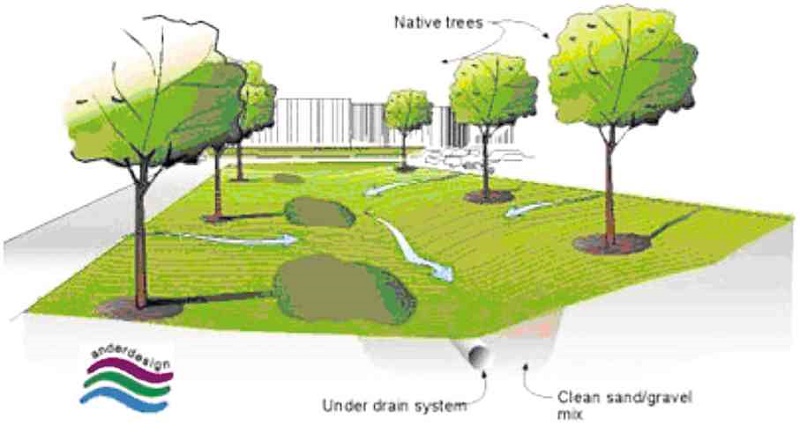
A SWALE system is a natural way to address the problem of drainage. It is made up of a gently sloping ditch or open canal with grass, to guide the water as it flows on the side of a road or a structure.
We are witnessing how rainwater flows over concrete gardens, or pavements and other hard surfaces that cover areas that were once covered with grass and vegetation. Rainwater flows over these hard surfaces filling up drains all at once.
To prevent flooding, we plant trees that absorb water. Keeping garden spaces around the house also helps. Porous or pervious pavements allow rainwater to gradually filter through the soil minimizing the impact of a sudden downpour. This reduces the cost of drainage. By allowing rainwater to filter through the soil, the aquifer or underground reservoir is naturally charged.
Green roofs are roof decks that have been converted into landscaped gardens. They act like a sponge-absorbing rainwater and delaying its release, giving the street drainage more time to flush out and discharge stormwater.
When it comes to handling rainfall, modern engineering tends to flush out rainfall as rapidly as possible through huge concrete culverts or gutters and elaborate drainage systems. In many cases, especially during a typhoon, the system creates more problems as the drainage system is incapable of handling the huge volume of water that causes flooding. What’s more, different kinds of contaminants get mixed up with sewage eventually polluting freshwater sources.
In the countryside, particularly in sloping land, uncontrolled heavy downpour can cause mudslides that can destroy lives and property, as we have witnessed in the past.
Conservationists now are one in promoting a simple solution—rainwater harvesting through swales.
What is a swale?
A swale system is a natural way to address the problem of drainage. It is made up of a gently sloping ditch or open canal with grass, to guide the water as it flows on the side of a road or a structure. As water flows through the ditch, a large quantity is absorbed by the ground reducing the need for a large and expensive concrete drainage system.
Floodwaters may be diverted into a temporary storage area like an open pasture. The water is kept in the area for about 48 hours before discharging it into waterways.
Benefits of swale system
A swale system slows down the flow of runoff water, that is, rainwater that flows over the surface of the ground. It also promotes infiltration, so vital for charging the aquifer, which is a layer of sand or rock that can absorb and hold water.
The swale is easy to design and can be constructed in impervious top soils. It traps sediments and other pollutants, thus increasing water quality. It is visually attractive and promotes beneficial habitat. It costs much less than the traditional concrete curb and gutter drainage system.
The Tokyo Metropolitan Government manages on-site water recycling systems that harvest rainwater in one or more large buildings and distributes the water within the buildings for nonpotable reuse. There, 61 percent of nonpotable water urban demand is met by reclaimed water, and the deficit is supplied by tap water from the city water supply. Biological treatment or ultrafiltration processes provide reliable treatment and suitable water quality. They find that a large on-site wastewater recycling system is more economically justifiable when compared to a conventional domestic water supply system.
EDGE tools
This building design tool, a certification system and a global green standard used in nearly 120 emerging market countries will be launched on Sept. 15 at the Asian Institute of Management Conference Center on Paseo de Roxas, Makati.
The EDGE software includes modules for homes, hotels, offices, hospitals and retail with building-specific user guides accompanying them. EDGE is an innovation of IFC, a member of the World Bank Group.
The Philippine Green Building Initiative or PGBI is the sole certifying body for EDGE projects in the country.
The EDGE tool aims to achieve 20 percent less use of energy, water, embodied materials and more.
EDGE aligns the interests of market players such as financial institutions, developers, government regulators and homeowners to promote resource-efficient building growth.
Please visit www.greenbuilding.ph, or call 225-0666 or email pgbi.secretariat@gmail.com.
For comments or inquiries, email amadodejesus@gmail.com
The Philippine Green Building Initiative or PGBI is the sole certifying body for EDGE projects in the Philippines. For information, visit www.greenbuilding.ph.

